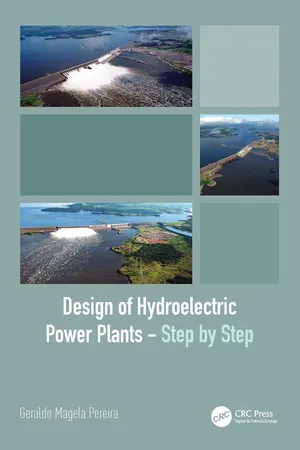
- 560 pages
- English
- ePUB (mobile friendly)
- Available on iOS & Android
Design of Hydroelectric Power Plants – Step by Step
About this book
The design of a hydroelectric plant, along with an installation of transformation of potential energy of water into electricity, is an activity that is not standardized. Each new project is an interesting engineering challenge, and teams need to work in different conditions of each site, integrated to design a functional, economical and environmentally sustainable project. The development of a project, here understood as the plant itself, the reservoir, the maneuver substation and the associated transmission line, is a multidisciplinary activity that encompasses areas of civil engineering, geology, mechanical and electrical engineering, environmental engineering, economic engineering, construction and assembly, and the engineering of operation and maintenance of civil works and electromechanical equipment. The book is organized to facilitate the performance of professional life of the new generations of engineers who will join the Electric Sector, or in other sectors that demand the knowledge regarding hydraulic structures. The book is a simple manual providing the practical step-by-step procedure for designing hydroelectric plants, including legislation, with a general view of the project.
Frequently asked questions
- Essential is ideal for learners and professionals who enjoy exploring a wide range of subjects. Access the Essential Library with 800,000+ trusted titles and best-sellers across business, personal growth, and the humanities. Includes unlimited reading time and Standard Read Aloud voice.
- Complete: Perfect for advanced learners and researchers needing full, unrestricted access. Unlock 1.4M+ books across hundreds of subjects, including academic and specialized titles. The Complete Plan also includes advanced features like Premium Read Aloud and Research Assistant.
Please note we cannot support devices running on iOS 13 and Android 7 or earlier. Learn more about using the app.
Information
Chapter 1
Hydroelectric powerplants
1.1 Introduction
- ICOLD, International Commission on Large Dams;
- BCOLD, Brazilian Committee on Dams;
- HPP, Hydroelectric Power Plant;
- WL, Water Level; WLres, Reservoir Water Level; WLmax, Maximum Water Level; TW, Tailwater Level;
- HDC, Hydraulic Design Criteria;
- EPC, Engineering, Procurement and Construction; etc.
1.2 The History
| Period | Type of use |
|---|---|
| Prehistoric | Springs |
| 3rd to 2nd millennium BC | Cisterns |
| 3rd millennium BC | Dams and wells |
| 2nd millennium BC | Gravity flow supply pipes of channels and drains, pressure pipes |
| 8th to 6th centuries BC | Lo... |
Table of contents
- Cover
- Half Title
- Title Page
- Copyright Page
- Table of Contents
- About the author
- Preface
- Acknowledgments
- Acronyms
- Symbols
- Greek symbols
- 1 Hydroelectric powerplants
- 2 Planning hydropower generation
- 3 Types of power plants and layouts
- 4 Hydrological studies
- 5 Power output
- 6 Geological and geotechnical studies
- 7 Dams
- 8 Spillways
- 9 Hydraulic conveyance design
- 10 Mechanical equipment
- 11 Electrical equipment: operation and maintenance
- 12 Construction planning
- 13 Risks and management of patrimony
- References
- Glossary
- Appendix: Chapter 3 – Additional examples of layouts
- Index